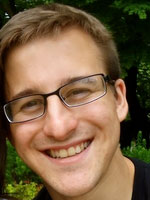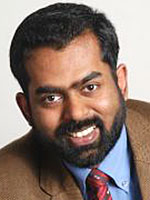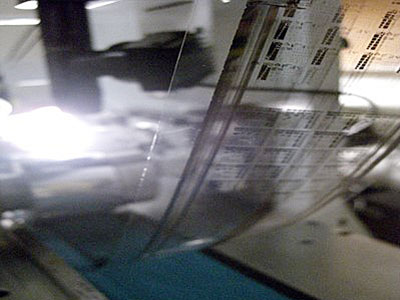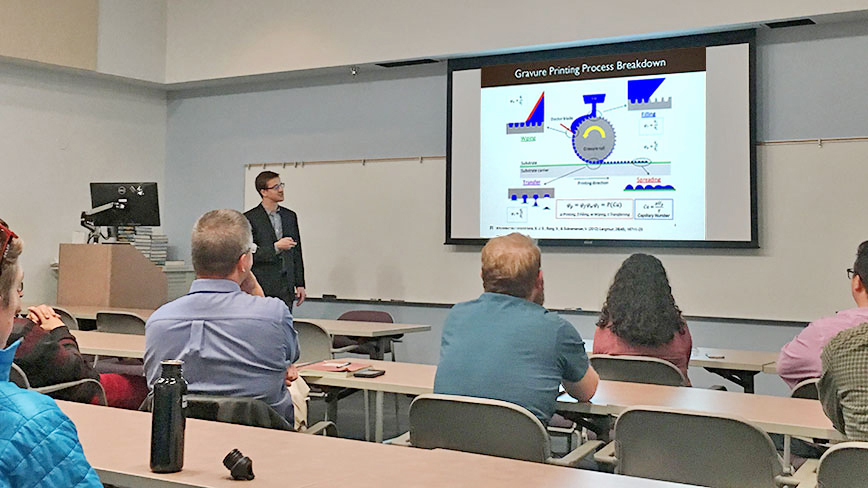Recent News
CHTM Joins NSF's NQVL Pilot Projects
August 9, 2024
OSE PHD, Dr. Xuefeng Li - Wins The Outstanding Interdisciplinary Graduate Programs Award
May 10, 2024
Dr. Ali Rastegari - 2024 OSE Best Dissertation Award Winner
May 10, 2024
2024 OSE Spring and Summer Graduates
May 10, 2024
News Archives
CHTM Special Seminar: Tooling and Ink Design for High Speed Gravure Printing of Nanomaterials
February 8, 2017

Will Scheideler
Will Scheideler, PhD candidate at the Electrical Engineering and Computer Sciences (EECS) department, University of California at Berkeley, visited CHTM on March 8, 2017 to discuss the work of the Printed Electronics Group at UC Berkeley in high-speed nanomaterial printing.
Printed electronics is a growing field of research that uses scalable, additive processing to pattern functional materials on a variety of substrates. With high-resolution printing and high-performance materials, devices such as low-power sensors or flexible displays, distinguished by their exceptional functionality and form-factor, are a possibility.

Vivek Subramanian
Dr. Vivek Subramanian, EECS Professor at UC Berkeley, is the Principal Investigator for the Printed Electronics Group and advisor for Scheideler.
The Printed Electronics Group at UC Berkeley covers research topics ranging from synthetic chemistry through complete electronic devices and systems, with the goal of ultimately enabling the use of printing-based electronics fabrication. This can usher in a broad spectrum of novel flexible electronic systems for enhanced comfort, public health, ease of use, safety, security, and availability.
The Printed Electronics Group utilizes well-equipped laboratories with extensive space for materials synthesis and formulation, printing and solution-processed device fabrication, and device characterization.
Subramanian and Scheideler are participants in the NASCENT Energy Research Group (ERC), funded by the National Science Foundation. Headquartered at the University of Texas at Austin, its partner institutions include The University of New Mexico and the University of California at Berkeley. Dr. Steven R. J. Brueck and students Leisha Armijo, Mahmoud Behzaridirad, Preyom Dey, Mohammadreza Zamani, Shima Nezhadbadeh and Juan Faria are among the NASCENT participants from CHTM.
Seminar Abstract:

Printing electronic patterns on a flexible substrate, image courtesy Printed Electronics @ Berkeley
Printed electronics is a growing field of research that uses scalable, additive processing to pattern functional materials on a variety of substrates (plastic, glass, paper, etc.). The exciting advantages of this approach include the ability to integrate various thin film devices and materials over large areas, and onto flexible substrates. Among many techniques, gravure printing offers superior resolution (< 5 μm) and high throughput (> 1 m/s) — advantages that make it an industrially proven, high-volume manufacturing technology used in the graphic arts.
The scope of gravure printed electronics has largely been dominated by materials whose lower performance produce severely limited applications. However, printed electronics need not be limited to cheap or disposable systems. With high-resolution printing and high-performance materials, we can imagine devices such as low-power sensors or flexible displays, which are distinguished by their exceptional functionality and form-factor.
In the Printed Electronics Group at UC Berkeley, we have worked to understand the governing fluid mechanics of gravure printing, design 0D and 1D nanomaterial inks to enable printing of high-quality devices, and develop new tools and processes for high-speed patterning.
This seminar will also discuss our recent work in which we applied that knowledge about the physics of gravure printing to design and construct a laboratory scale sheet-fed gravure printer for high speed nanomaterial printing with high registration accuracy. By decoupling each of the subprocesses of gravure in this new tool, we are then able to develop a greater understanding of the ink transfer, doctoring, and filling of nanomaterial inks.
View / download seminar abstract as PDF
Will Scheideler presentation in CHTM 101:

Scheideler was introduced by Dr. Randall Schunk, National Laboratory Professor with the UNM Department of Chemical and Biological Engineering, who highlighted the connection UNM enjoys with UC Berkeley as a partner in the NASCENT ERC. Scheideler's presentation on what they've learned about nanoscale printing at UC Berkeley EECS was well received by those in attendance, which included Dr. Steven R. J. Brueck.


